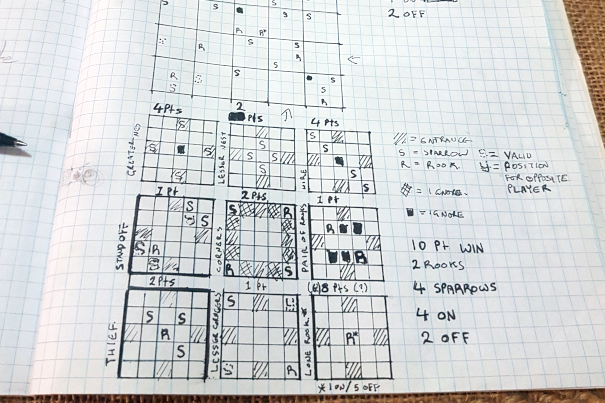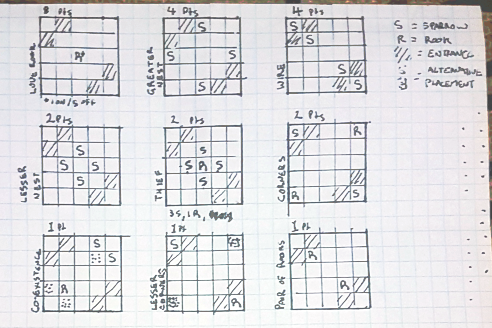To get things started quickly I decided to make a quick Minimal Viable Product. Version 1.0 looked something like this:
- 2 players
- A central 5x5 grid as a playing board
- 6 pieces per player, called birds
- 2 larger Rooks (as in the bird, not the chess piece)
- 4 smaller Sparrows
- Players are separated into two colours — 1 set of Rooks and Sparrows are blue, the other red. (These colours are what I had in my stash, but will probably change)
- For the prototype I'm using large discs for Rooks and small discs for Sparrows, but might change eventually
- A player may have 4 of their birds on the board at any time.
- 4 entrance and exit cells to sub pieces in and out.
- I call these gates
- Score 10 points for win
- Certain arrangements of a player's own pieces score certain points
- I call these Plays. There are 9 Plays to choose from
- These are listed on a playsheet for reference. Both players have a copy of this.
For Plays, I made up a few (mostly) symmetrical arrangements based on a loose avian theme of Sparrows and Rooks sharing a garden.
 The first 9 plays, scribbled in a hasty brainstorm.
The first 9 plays, scribbled in a hasty brainstorm.
I figured most of the above list items would change after playing it a few times. But the system has mostly held up, so far, over quite a few games.
Gameplay
The For this version, the gameplay proceeds thus:
The game is played in 2 phases: Flock and Hop.
Flock (Phase 1)
Players take turns to place one bird on the board each turn. This may be any combination of Ravens and Wrens. Flock ends when both players each have 4 birds on the board.
Hop (Phase 2)
Players take turns to move 1 of their birds exactly 1 square (both orthogonal and diagonal are permitted). Players must make a move on their turn. There may only be 1 bird in each square, however there are no other limits to which square a bird may move.
Players may also move birds off or onto the board (see flying below).
Flying
Players each have 6 birds, but are only permitted a maximum of 4 each on the board at any one time. It is possible to move birds on and off the board by flying them.
A bird may only be moved off or onto the board through a gate.
To Fly Birds
- Move bird onto any Gate (1 turn)
- Move bird off board (1 turn)
- (Optional) Move new bird onto any available Gate (1 turn)
Points
Points are scored by arranging one's own birds into pre-defined arrangements — or plays — found on the playsheet. Once a player's own birds on the board match a play on the playsheet, they announce which one they have formed and record the associated points. A player cannot form the same play twice in a row.
When a player has scored at least 10 points they are declared the winner and the game ends.
Example Play Sheet (prototype)

A cleaner image of the playsheet notating all possible plays. The gates are the hashed squares. Special rules you might not make out are:
Lone Rook: must be the player's only piece on the board;
Thief: Player only needs 3 Sparrows on the board, but they may be in any of those positions.
First Results
Gameplay is fairly quick (10–15 mins), and there is a tension between whether to score points or block the opponent from scoring. I was satisfied at this point with the number of pieces. The close quarters meant no move felt insignificant as a bird made it's way to form a new play.
The game may be a no-brainer for a seasoned chess player — but the target audience is probably a light–mid weight player. My biggest concern remains that the game is easily solvable, and will be reduced to a pre-set sequence of plays too easily. Though I definitely need to expand the play-test circles to see if that concern is realistic.
Becoming Version 1.1
My first real change was the position of the gates from centred to asymmetrical.
Changing the position of gates has two advantages: it's harder for pieces to reach certain cells from the gates, and some Plays I really like thematically aren't blocking the gates. And the board still looks the same from both sides of the table.
Note: This happened before the first play tests. But writing it down here is unobtrusive to the flow of this write-up.
My first actual change was to adjust the theme slightly from Sparrows and Rooks to Wrens (because my wife loves Australian Fairy Wrens) and Ravens (also because Australian Birds, and to differentiate between birds and castles).
After a couple of games against my wife it became clear that I needed to restrict where Ravens are placed during Flock. I was able to score easy points by placing a Raven into the middle of the board (especially during these earlier sessions where the Thief scored 4 points and Hræfn commanded 8!).
I'll be writing more on the next iteration in the next journal entry…
*EDIT: Clarified some images, added a better explanation of rules and gameplay thanks to questccg's suggestions :)



Comments
Good some clarification does HELP!
However, I still feel there are omitted details about the game...
WHO scores the points when there are configurations that depend on BOTH pieces. Like "Half Corners" score 1 Point. This is made up of BOTH pieces: one Raven and one Wren.
Does you opponent need to partake on ONLY your own pieces?!
I think there is where MOST of the confusion lies. Like "Thief" is it YOUR Raven combined with 3 of your OWN Wrens? Why can't I just play ONE (1) Raven at the start of the game as Player #1, and move my Raven to the Center of play and score 6 Points???
There is something that I am NOT understanding or the game has an inherent flaw in the 6 Point "play"...
Looks like I need to re-word some rules
Thanks for the continued critique. :)
As I said in reply to your last comment, I'm using this journal to document the stages of development.
I'll add this is because I regret not doing so right from the start. I don't know if you've read the other entries, but I'll get to Version 2.0 in the next post (which is half written and most likely going up after this here reply).
I know this is an unconventional approach, but it satisfies my OCD and need for proper posterity. After seeing the naming of billy_mcauley's dev diary I've updated the title of these entries to read likewise. :D
So for example:
In Half Corners if Blue Player has their Wren in the top left corner, and Red Player has their Raven in the bottom right, nobody scores. If Red Player manages to eventually get their own Wren into the top left corner, and Raven in the bottom right then Red Player wins the point.
This is what I meant by blocking others. If I can put my piece in their way, they can't score. But it also means I've wasted a turn not scoring, and one of my pieces is no longer available for forming a play.
There is something that I am NOT understanding or the game has an inherent flaw in the 6 Point "play"...
Two things here (and I've updated the write-up to clarify).
For Hræfn (at this stage of development it was called Lone Raven) the central Raven must be Player #1's only piece on the board. Otherwise it doesn't score (It was written on the playsheet on the original entry).
So to do what you're suggesting one would have to:
This would be an inefficient use of the first third of the game, considering you would need to bring more birds onto the board to score any more points. I've hopefully clarified this rule in the caption for the playsheet.
But as I wrote at the end of the journal… "I'll be writing more on the next iteration in the next journal entry…" I'll post the new entry soon. :)
Is this some form of "complex" Tic-Tac-Toe??
I'm not sure HOW this game is played?! Do you start with an EMPTY Grid and then place pieces (birds) and other types of pieces to block your opponent?!
It looks interesting. But might SEEM a little short on "strategy". I could be wrong, it might actually have a surprising depth to the game.
But no explanation about HOW the game plays, means it's very hard to partake in am meaningful discussions with you, the Designer, because all we are looking at are some scribbles in a notepad.
In your NEXT Journal entry, you should focus on writing HOW the game is to be played, the various pieces involved, how does one WIN a game, etc. All that "good stuff" that will better help understand WHAT is going on...
Cheers!
Oops, that's an oversight!
Thanks for the comment! I wasn't really expecting much attention yet. :)
A bit of an oversight for me here, as a newbie designer.
This is a journal on a project that has been going for a few months, so I'm introducing the process as it was in each stage. This stage was still a bit scribbly, I'm afraid. Perhaps this is the wrong approach? I'll be posting clear diagrams and updated rules further on.
That said, I'm okay to aim it at light to mid weight gamers. Perhaps an entry-level game to the world of abstracts. My biggest concern is that the game will be too easily solvable for a math wiz. Which I am certainly not!
I do have in mind an expansion of sorts that adds a modern twist or two. But that's for a later journal. :)